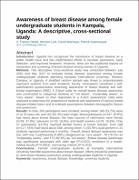| dc.contributor.author | Okedi, X Francis | |
| dc.contributor.author | Lule, Herman | |
| dc.contributor.author | Wachaya, David | |
| dc.contributor.author | Kyamanywa, Patrick | |
| dc.date.accessioned | 2022-04-27T07:43:47Z | |
| dc.date.available | 2022-04-27T07:43:47Z | |
| dc.date.issued | 2020 | |
| dc.identifier.citation | Okedi, X.F., Lule, H., Wachaya, D. and Kyamanywa, P. (2020). Awareness of breast disease among female undergraduate students in Kampala, Uganda: A descriptive, cross-sectional study. East and Central African Journal of Surgery, 25(4). | en_US |
| dc.identifier.issn | 2073-9990 | |
| dc.identifier.uri | http://journal.cosecsa.org/index.php/ECAJS/article/view/20180030/1695 | |
| dc.identifier.uri | http://hdl.handle.net/20.500.12280/2969 | |
| dc.description.abstract | Introduction: Uganda has recognized the importance of breast disease as a public health issue and has implemented efforts to increase awareness, early detection, and improved treatment. However, there are few published reports on awareness and screening of breast disease among women in Uganda.
Methods: This descriptive cross-sectional study was conducted between July 2016 and May 2017 to evaluate breast disease awareness among female undergraduate students attending Kampala International University, Western Campus, in Uganda. A stratified random sample was drawn to proportionately represent students from each academic faculty. Participants completed a self-administered questionnaire assessing awareness of breast disease and self-breast examination (SBE). A 3-level scale for overall breast disease awareness was constructed to categorize students as “not aware”, “moderately aware”, or “very aware”, based on their responses to a 3-item assessment. Data were analysed to determine the proportion of students with awareness of various breast disease-related topics and to evaluate associations between demographic factors and awareness.
Results: In total, 209 participants were enrolled, among whom 108 (51.7%) were 21 to 25 years old, and 192 (92.3%) were single. Most participants (n=197, 92.8%) had heard about breast disease; the main sources of information were friends (n=59, 27.8%), television (n=33,15.8%), and health workers (n=33, 15.8%). Only 27 participants (12.9%) reported familial history of breast disease. Over half (n=117, 55%) had heard about SBE, among whom 71 (60.9%) could perform it; 23 students reported performing it monthly. Overall, breast disease awareness was low, with only 2 participants (0.96%) categorized as “very aware”, 76 (16.3%) as “moderately aware”, and 173 (82.8%) as “not aware”. Breast disease awareness was significantly associated with older age (P=0.023), enrolment in a health-related faculty (P<0.0001), and having children (P=0.016).
Conclusions: Female undergraduate students at Kampala International University had little awareness about breast disease. Efforts should be undertaken to raise breast disease awareness among undergraduate students in Uganda. | en_US |
| dc.language.iso | en | en_US |
| dc.publisher | The College of Surgeons of East, Central and Southern Africa (COSECSA) | en_US |
| dc.relation.ispartofseries | East and Central African Journal of Surgery;25(4). | |
| dc.subject | Awareness | en_US |
| dc.subject | Breast disease | en_US |
| dc.subject | Knowledge | en_US |
| dc.subject | University students | en_US |
| dc.title | Awareness of Breast Disease Among Female Undergraduate Students in Kampala, Uganda: A Descriptive, Cross-sectional Study | en_US |
| dc.type | Article | en_US |


